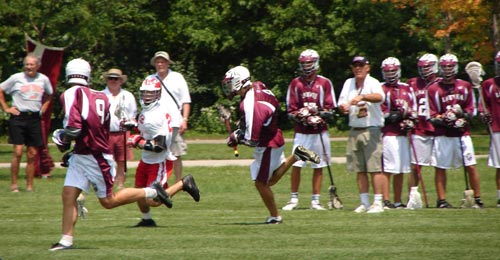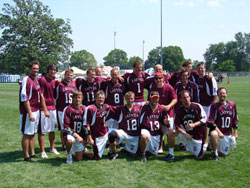Latvia recently made its world debut in yet another athletic competition, this time in a sport not all that familiar to folks back home – lacrosse or, as it is called in Latvian, lakross.
Originally part of Native American religious and community life in what is now Southern Canada and the Northeastern United States, lacrosse was picked up by non-natives and in 1859 was named Canada’s national game. Over the next century the sport spread to the United States and countries of the British Commonwealth.
In the early part of the 20th century, lacrosse in Canada was eclipsed by hockey. Lacrosse was married with hockey and the indoor version, or box lacrosse, became the dominant form of lacrosse in Canada. Today, it is played by thousands across Canada – youths, juniors and seniors. The National Lacrosse League is a professional circuit that has grown in popularity on both sides of the border. In recent years, crowds of more than 10,000 have not been uncommon. Meanwhile, field lacrosse took root in American high schools and colleges particularly on the East Coast.
The International Lacrosse Federation (ILF) holds World Championships in field lacrosse every four years. The United States has been the dominant power for a quarter of a century. Canada and Australia have been runner-ups. The 2006 championships were held July 13-22 in London, Ontario, about halfway between Toronto and Detroit, Mich.
Twenty-one teams were divided into four divisions for round robin play. Latvia played in the yellow division consisting of the lowest-seeded teams. Latvia lost its opening game to eventual division winner Finland (3-9) and then followed with victories against division rivals Spain (11-9), Denmark (7-3 and 5-3) and Bermuda (9-3), before losing to higher-ranked Netherlands (4-10) and Wales (2-18). Latvia finished 14th. The gold medal went to Canada, which finally beat its rival, the United States.
In e-mail interviews, Andris Dikmanis, a Team Latvia player and director of the Latvian American Lacrosse Organization, and Stephen Jacobson, coach of Team Latvia, talk about lacrosse and Latvia.
Latvia and lacrosse. It seems like an unlikely combination. How did lacrosse get started in Latvia?
Dikmanis: The game of lacrosse was first introduced to the Baltic region in 1992 in the form of Intercrosse. The first real lacrosse practices and developmental programs were started in the summer of 2002, followed by regular team practices in several Latvian cities the following year. Currently Latvia is home to two lacrosse clubs and more than 30 players. The larger of the two is the Mitavas Lacrosse Club with players from several cities including Rīga, Jelgava and Ogre. The Latvian National Lacrosse Team in 2003 participated in their first European Newcomers Lacrosse Championship in Salzburg, Austria, as well as in the 2004 European Lacrosse Championship in Prague. The team then set its sights on the World Championships. Last summer the LALO organized a week-long exhibition and camp in Latvia to showcase the players from each of their cities.
Tell us about yourself and how you got involved with Latvian lacrosse.
Dikmanis: I am a former Division 1 player from the United States who played with Hofstra University. I enjoy the game and when I became aware of an attempt to form a competitive Latvian national team, I volunteered to play for the team and help organize and recruit some experienced players of Latvian descent. It became evident that the team needed financial help and publicity concerning their efforts. As a result, I utilized my computer experience to construct the LALO Web site and started a campaign to raise funds. With the help of the lacrosse network throughout the United States, we gained partial sponsorship from Warrior Lacrosse. This enabled us to purchase our uniforms and equipment at reduced cost. By producing Latvian lacrosse paraphernalia, we were able to raise additional funds for the team.
Latvia made its debut at the World Championships this year. How did that happen?
Dikmanis: Aigars Grinbergs in Latvia wanted to send a team to participate in the international arena. I volunteered to help train the Latvian team last summer where they held a camp in Gramzde. It became evident that there was a great amount of work to be done. Consequently an infusion of experienced players of Latvian decent was necessary to make the team competitive. Aside from the competitive aspects, we are proud of their effort to break into the international scene of lacrosse and we wanted the team to succeed.
The players from Latvia were joined by five from the United States. How and why?
Dikmanis: Judging from the results and the actual play in the tournament, the players from the United States helped the inexperienced players from Latvia rise to a new level. At the end of the World Championships, the Latvian players left with a great deal of pride and recognition of how much they had improved over the two-week period by playing with and against other experienced players.
Could you share your favourite memory from the World Championships?
Dikmanis: First there was the thrill of representing Latvia in the opening ceremonies. Then came our first win against Spain, a team that had an excellent offense and it was up to us to shut them down. It was a legitimate victory that instilled confidence in our team and it convinced them that they were for real. Next was our first win against Denmark. When my father suggested that we could beat Denmark the night before, certain people thought he was crazy. When we won, I can remember the big grin on his face and the words, “I told you so.” He truly believed in us and the determination of this rag-tag team that only came together to practice three days before the beginning of the tournament and made it happen. The second time we beat Denmark was validation of our first victory. We are for real and we will only get better.
What’s next for Latvian lacrosse?
Dikmanis: We have had Latvians crawling out of the woodwork expressing interest in our efforts. We hope to run summer camps in the United States or Canada, and Latvia, where new players can develop their skills. We want to popularize this sport in Latvia with the thought in mind that, if you like hockey, lacrosse is similar to hockey—just without the ice. We hope that our remarkable results in the World Championships will kindle interest among Latvians everywhere.
You met your team for the first time just prior to the World Championships. Tell us about the challenges you and the team faced.
Jacobson: When we first met, eight of the 12 native Latvian players had never played an organized game prior to this. They had to be taught offensive plays and positioning on the field. Considerable time was spent improving the team’s stick skills. We had to find several face-off players and players capable of playing the wing positions on the face-off team. We worked on teaching the players how to play a zone defense and how to slide when help was needed. I felt we could have used several weeks of practice before this tournament. However our first game was against the strongest team in our division, and we were not quite ready. I felt we had a chance to win perhaps one game—against Bermuda. A win against Spain was only possible if our two best defensemen could shut down the two main scorers of the Spanish team. When we limited their best players to two goals, we were able to achieve victory. From that point on, the team played with greater confidence and demonstrated the perseverance to win.
How satisfied are you with the guys and the performance of the team?
Jacobson: The results achieved are beyond my wildest expectation. To achieve a winning record by an affiliate nation in its first appearance in the World Games is significant. There were teams that have been playing together in tournament play for many years that did not fare as well as we did.

Latvian defenders converge on a Danish attacker during the 2006 World Championships, while teammates, coaches and spectators watch from the sidelines. (Photo by Viesturs Zariņš)

Team Latvia poses for a photograph after its 7-3 victory against Denmark in the World Championships. (Photo by Viesturs Zariņš)
© 1995-2024 Latvians Online
Please contact us for editorial queries, or for permission to republish material. Disclaimer: The content of Web sites to which Latvians Online provides links does not necessarily reflect the opinion of Latvians Online, its staff or its sponsors.




